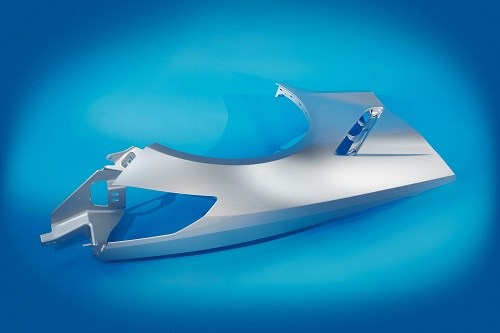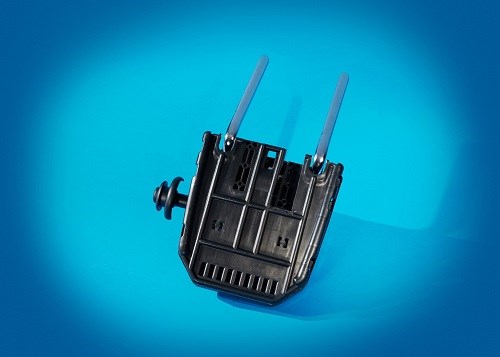Winners of SPE Auto Innovation Awards in Materials and Body
Lots of "firsts" highlighted the 2015 SPE Automotive Innovation Awards.
Spanning nine categories, the winners of the SPE Automotive Division 2015 Blue Ribbon Automotive Innovation Awards, for which delightedly I was a participating judge, are unique and represent many “firsts”, whether it be metal replacement or a better plastic replacement. Thermoplastics weighed-in in six of the awards, with thermosets featured in two, and a fabric made of 100% recycled PET bottles among the “firsts”.
Take a look at the materials category whose winner was selected the “grand award winner”, as well as the body interior and body exterior winners.

Materials: Ultralight Class A Body Panels
GM’s 2016 Chevrolet Corvette sports cars feature 21 body panel assemblies, depending on the model, made with the new TCA (tough Class A) Ultra Lite SMC, a compound formulated and compression molded by Continental Structural Plastics, Auburn Hills, Mich. With a specific gravity (SG) of 1.2, this SMC compound, offers mass reductions of 28% and 43%, respectively, versus CSP’s 1.6 SG TCA Lite SMC and conventional 1.9 SG SMC grades.
The 19% (>20 lbs) weight savings achieved with the new TCA Ultra Lite vs the earlier TCA Lite was enabled by the use of hollow glass microspheres which replaced traditional heavier fillers such as calcium carbonate, along with CSP’s proprietary surface treatment on the microspheres which promotes chemical bonding to the unsaturated polyester resin matrix. The improved resin/microsphere interface plays a key role in boosting both mechanical properties and adhesion properties for the SMC components. Also touted is improved paint adhesion, especially after humidity or water exposure. Superior surface treatment and paintability are key features of these ultralight Class A body panels which include: doors, decklids (trunks), hatch, door surrounds, quarter panels, fenders, convertible tonneau assembly, and coupe roof bow.

Body Interior: Rear-Seat Folding Head Restraint
The Ford 2015 F-150 pickup features a rear-seat, folding head restraint that eliminates a welded steel structure and replaces it with a single-piece, living hinge thermoplastic core as its main structural component. (Typical rear head restraints use steel underpinning covered in plastic shrouding.) Automotive global Tier I supplier specializing in custom head restraints and armrests Windsor Machine Group and custom molder Hawk Plastics, both based in Ontario, teamed up to design and injection mold this unique head restraint using a standard random PP copolymer from Exxon Mobil Chemical.
This unique single-piece plastic core results in reduced thickness from 2.56 in. to 1.26 in. for improved comfort and rear visibility, a mass savings of 1.38 lb/vehicle, while significantly reducing manufacturing complexity by eliminating the need for special tooling processes thanks to consolidation of five parts into one. Tooling costs are reduced by $180, with piece price reduced by $1.50/vehicle, while still meeting or exceeding all global safety requirements. Moreover, the technology has been applied to the 2016 Ford Explores and is planned for at least three additional programs.

Body Exterior: Push-to-Release Exterior Serviceability Fastener
The 2015 Ford Mustang features a unique fastener that only requires that you push the center pin to the service position to remove—an 80% reduction in removal time--compared to other easy-service fasteners which have two twist heads to release along with the risk of unintentional removal.
Designed and manufactured by ITW Deltar Fasteners, Troy, Mich., the new fastener is made of Vydyne 47H nylon 66 from Houston-based Ascend Performance Materials. The pin and body are designed not to be easily separated; however, the fastener is reusable, unlike other push pins that become damaged in the process of removal. The part meets the 10-lb insertion ergonomic requirement, and the EU ECE-R04 lighting service regulation, and its low profile meets exterior craftsmanship. It decreases the chance of unintended release: it cannot back out or be removed from the install position without deliberate actions by the customer. Finally, there is a 10% cost reduction in piece cost from comparable service fasteners on the Mustang.
Related Content
Recycled Material Prices Show Stability Heading into 2023
After summer's steep drop, most prices leveled off in the second half.
Read MorePolyethylene Fundamentals – Part 4: Failed HDPE Case Study
Injection molders of small fuel tanks learned the hard way that a very small difference in density — 0.6% — could make a large difference in PE stress-crack resistance.
Read MoreFundamentals of Polyethylene – Part 3: Field Failures
Polyethylene parts can fail when an inappropriate density is selected. Let’s look at some examples and examine what happened and why.
Read MoreFormulating LLDPE/LDPE Blends For Abuse–Resistant Blown Film
A new study shows how the type and amount of LDPE in blends with LLDPE affect the processing and strength/toughness properties of blown film. Data are shown for both LDPE-rich and LLDPE-rich blends.
Read MoreRead Next
Processor Turns to AI to Help Keep Machines Humming
At captive processor McConkey, a new generation of artificial intelligence models, highlighted by ChatGPT, is helping it wade through the shortage of skilled labor and keep its production lines churning out good parts.
Read MoreAdvanced Recycling: Beyond Pyrolysis
Consumer-product brand owners increasingly see advanced chemical recycling as a necessary complement to mechanical recycling if they are to meet ambitious goals for a circular economy in the next decade. Dozens of technology providers are developing new technologies to overcome the limitations of existing pyrolysis methods and to commercialize various alternative approaches to chemical recycling of plastics.
Read More














.png;maxWidth=300;quality=90)









